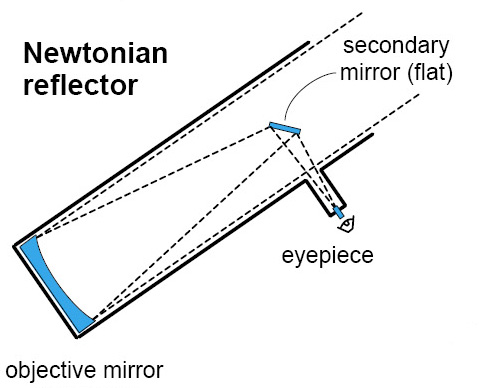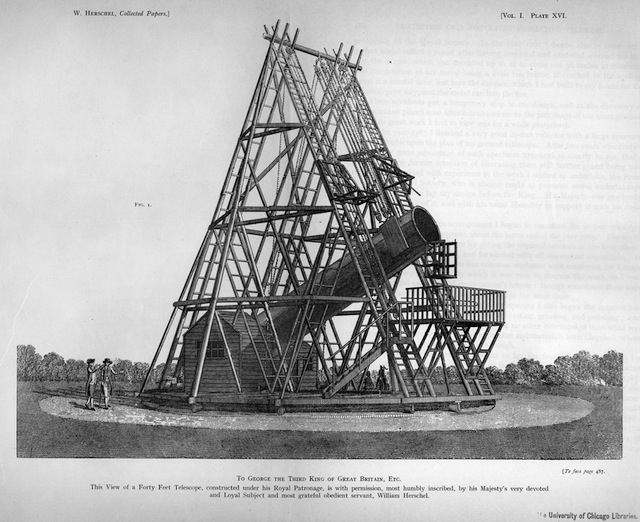Refractors
Astronomical telescopes are of two general types. The refractor is a telescope that passes light through an objective lens, then through an eyepiece. Galileo used a refractor to study the Moon and Jupiter. The diameter of the objective lens determines the light gathering ability. Double the diameter and you get four times the amount of light.

The world’s largest diameter refractor objective lens is 40 inches in the Yerkes Observatory telescope in Williams Bay, Wisconsin, northwest of Chicago. Their excessive weight and length make them unsuitable any larger. They can’t be supported well enough to avoid warping of the long tube. Some notable people who have used the Yerkes telescope include Edwin Hubble, Subrahmanyan Chandrasekhar, Russian-American astronomer Otto Struve, and Carl Sagan.

A. Einstein – Courtesy Yerkes Obs.
Reflectors
The second general type is the reflector. Isaac Newton developed a useful design. For this reason, the telescope is often called the Newtonian. Light is reflected off of a concave mirrored surface, parabolic for the highest quality telescopes. From there it reflects off of a small diagonal flat mirror at 45˚ and then through an eyepiece. Again, the diameter determines the light gathering ability. These telescopes don’t suffer from the aberrations caused by light passing through an objective lens as in the refractor.

This large and ungainly 40 foot long 48 inch diameter Newtonian was built in 1785 by William Herschel. He and his sister Caroline used it to look for faint objects. Nebula clouds and spiral objects were discovered and thought to be comets. Galaxies were not known then.

U. of Chicago Library
Cassegrain Reflectors
Another style of reflector is called the Cassegrain. It reflects the light from the objective mirror off of a smaller secondary curved mirror and back through a hole in the objective to an eyepiece. These telescopes can be made much larger than a refractor. Their size and weight can be supported better. This design effectively shortens the telescope tube length. It is much more compact relative to its diameter.

The largest telescopes in the world are of the Cassegrain type. Some single mirrors of 8.4 meters (27.6 feet) diameter are being made for them today. One such telescope, the Giant Magellan Telescope, is scheduled for completion in 2019. It will use 7 of these large mirrors together for an overall effective diameter of 24.5 meters (80 feet). Currently, the third of the seven mirrors is in production. The finished assembly will look like this. Note the human figure in the scene. Quick facts are here.
Only one mirror has a hole in the center as in the Cassegrain design. All seven will reflect their light to the smaller curved mirrors on the end of the supports. There, the light will reflect down and through the hole in the center mirror to the observing instruments. How do you build such large mirrors?

GMTO Corporation 251 S. Lake Avenue, Suite 300 Pasadena, CA
The mirrors need to be as light as possible. They cannot be made of a thick piece of solid glass. Instead, they are built in a honeycomb hollowed out structure. It is a remarkable story of engineering and technology. The story of how these enormous mirrors are made is the next part of this post. Watch for it next time.

It is astonishing how we advance. A little more than 200 years ago, we had reached our limit for being able to peer into the universe. Now we can see the instant of the Big Bang. What will come next? Can we even imagine it?
It is really awesome when you think about how far we have come.
Hi Jim,
Great article.
Hey, thanks, and nice to see you.
The design of telescope lenses is, I submit, a good example of the practical application of mathematics, i.e., geometry in this case. In a Cassegrain reflecting telescope the primary mirror is a parabola and the secondary mirror is ground to the shape of a hyperbola. Understanding the properties of those curves, i.e. their focal points, enables the mirrors to be ground precisely and achieve near perfection in imaging. Distortions and aberrations are effectively eliminated. I hope some of your readers will show this post to their teens who might be interested in engineering and science.
I hope they will do that, too. The near perfection of the curves is amazing. The Hubble mirror was ground about as perfectly smooth as possible at the time. But, a measurement error in the polishing system added a near-perfect spherical aberration.
http://www.spacetelescope.org/about/history/aberration_problem/
Knowing the nature of the problem allowed a correction to be made to gain its excellent sight.
Thank you, Jim.
I have to admit that I use a telescope only for looking at birds. I can identify species half a mile across the bay (so long as it’s not a warm day when convection makes the surface of the water blurry) which is much better than binoculars. I’m borrowing a refractor right now. A relative offered me a reflector scope but it would be no use for me since I can’t make the images right side up the way I can with the refractor. While left and right makes no difference, I can’t ID a bird upsidedown. One of these days I’ll have to return the telescope, and figure out another way to see birds far off, possibly just buy a spotting scope. The magnification limit on them seems to be an 80mm objective, but even that depends on the quality of the lens. A bit of research to do. Thanks for the overview of telescope designs.
Your bird-watching comment got me to thinking about the inverted image problem with reflecting telescopes, OD. It occurs to me that a digital SLR camera might be the answer to your problem. I have read that they now come with telescopic lenses, just like the older versions, and, they have image stabilization.
A reflector would make ID-ing birds very challenging. A good spotter scope can be fairly compact. You would probably find it very useful.
For magnification, divide the objective mm by the eyepiece mm. I think anything above 25x or 30x is probably hard to keep steady and narrows your field. In sky viewing, I seldom use 75x. Image quality degrades, too.
Happy hunting.
We can say that these are your reflections on telescopes.
Next will be reflections on mirrors.
Dang … no wonder telescopes have to be so big!
Not only big, but the mirrors are somewhat flexible. They can be warped slightly to correct for atmospheric changes all within fractions of a second. It’s like your eye’s ability to adapt to changes.
Flexible mirrors must be a special material. Do you know what they are made of?
Glass. The only bend a tiny amount. But, that is enough.
Thanks.
Did you know about or take part in the Galileoscope Project during the year of astronomy? There’s some information about it here. It was a wonderful idea, meant to put inexpensive but usable telescopes in the hands of kids around the world. There were resources in the program meant to educate on the nature of telescopes, how to use them, and so on.
Yes, I did. I bought one for each daughter to share with our grandkids. They were very good quality scopes.
May I have your authorization to publish this on twitter?
Yes. You may do that.
Sorry to be slow in response. It’s been busy.
Thank you…Jim